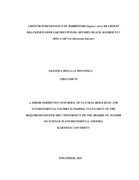GROWTH PERFORMANCE OF RABBITFISH (Siganus sutor) REARED IN BRACKISH WATER EARTHEN PONDS, OFFERED BLACK SOLDIER FLY (BSF) LARVAE (Hermetia illucens)
Abstract
The trend in mariculture development in Kenya is rising as the population and the demand for food increases. Rabbitfish (Siganus sutor) is a suitable candidate for mariculture in Kenya since it can be raised in ponds, accepts formulated feeds, and has a better growth performance as compared to other marine finfishes. It is also acceptable to local and international consumers and thus will have no marketing problem. Currently, S. sutor is the most targeted species and heavily fished on the Kenyan coast and Mariculture would increase its availability and sustainability. This study presents a 90 day’s first trial on the growth performance of S.sutor fed on black soldier fly meal in brackish water environment on the north coast in Kenya earthen ponds (hapa nets). The study had a complete block randomized design (CBRD) with four treatments, which were performed in triplicates and assigned randomly among twelve hapa net cages set in three rows (black nylon, sized (#1mm) and 1.5 x 1.0 x 1.2 meters). S.sutor were stocked at 15/fish/hapa and fed twice a day (0900HRS and 01600HRS) at 5% body weight throughout the study period. The cages were allocated treatments randomly as, T1 100% black soldier fly larvae, 0% fish meal, T2 25% fish meal replaced with 75% black soldier fly larvae), T3 50% fish meal was replaced with 50% BSFL and T4 was used as a control (40% commercial feed). Sampling was done monthly for total length (cm) and weight (g). The results showed that 100% BSFL feed had the highest initial mean weight of 36.06±0.99g, 40% commercial feed had the lowest at 33.76±0.68g. The highest final mean weight was observed in T1, (100% BSFL) at 68.36±0.42 and T2, (25% fish meal 75% BSFL) the lowest at 57.28±0.33g. Feed conversion ratio (FCR) in all diets and growth performance among the different treatments had no significant difference (p<0.05) at (F=6.9122, df=3, p<0.05). The water temperatures, pH, salinity, dissolved oxygen (DO), nitrogen (NH3-N), Nitrites - nitrogen (NO2-N) and total ammonia (NH3-N) values in all treatments were within the optimal limits for S. sutor growth. The study reports useful information on the growth performance and survival of S.sutor fed on black soldier fly larval diet. These findings, from this study revealed that S. sutor is suitable for culturing in brackish waters and the community can easily benefit from the species and act as food security and provide an alternative source of income for rural communities.
